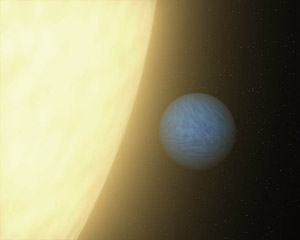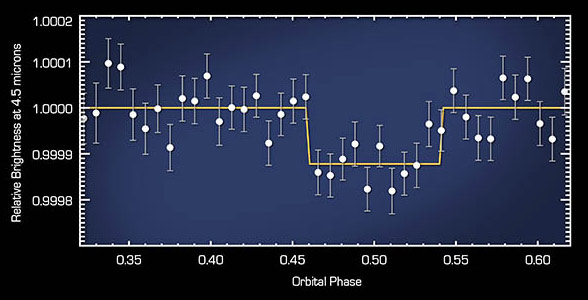Create a free profile to get unlimited access to exclusive videos, sweepstakes, and more!
Spitzer sees the glow of a boiling planet

 Since the first planet was discovered orbiting another Sun-like star in 1995, nearly 800 more have been discovered. Only a handful have been directly detected: most are discovered by their influence on their star, either by tugging it or blocking its light as the planet orbits (at the bottom of this post is a gallery of images of exoplanets detected in these ways). But some have been directly seen: either glowing by their own light, reflecting that of their star, or -- ironically -- seen when they're not seen.
Since the first planet was discovered orbiting another Sun-like star in 1995, nearly 800 more have been discovered. Only a handful have been directly detected: most are discovered by their influence on their star, either by tugging it or blocking its light as the planet orbits (at the bottom of this post is a gallery of images of exoplanets detected in these ways). But some have been directly seen: either glowing by their own light, reflecting that of their star, or -- ironically -- seen when they're not seen.
Say what? OK, this takes a sec to explain, but it's cool.
The star 55 Cancri hosts at least 5 planets. Located 40 light years away, it's one of the closer planetary systems, and has been intensely studied. One of the planets, 55 Cancri e, is bizarre: it's twice the diameter of the Earth and has 8 times our mass. It's thought to have a dense core surrounded by water... but Earth-like it ain't. It orbits its star in a very tight orbit, circling it once every 18 hours. It's so close to the star that the surface temperature is probably around 1700°C -- or 3100°F! That's hot enough to melt lead.
So yikes. If it does have water, it's in the form of a weird super-heated steam only held to the planet due to its strong gravity. Even then, the atmosphere may be boiling away like a gigantic comet. So again, this isn't like Earth at all. Even Venus isn't this unpleasant, and on Venus it rains sulfuric acid.
Anyway, an object at that temperature will glow in the infrared, quite strongly. If it were sitting all by itself in space, it would be easy to see. However, it's sitting next to a star which is millions of times brighter, making it a significantly more difficult target.
... but not impossible. The orbit of the planet 55 Cancri e is edge-on as seen from Earth, so every 18 hours the planet crosses in front of the star. When it does, the starlight dips a bit because the planet blocks it. However, if you wait 9 hours, the planet will pass behind the star. Even though the star is far brighter, that means there's still a small dip in the total infrared light emitted by the system (the folks at Spitzer have a nice graphic showing how this works).
Using the infrared-viewing Spitzer Space Telescope, astronomers observed the star 55 Cancri and waited for the planet to go behind the star. What they saw was this:
The points represent the amount of infrared light they measured (at 4.5 μ, well outside what our eyes can see), and the x-axis is time. As you can see, the light from the star dipped a bit. Not very much! The depth of the eclipse is only about 0.01%, but that's enough to see. And by observing the event over and over again they were able to get pretty good statistics, and confirm they are seeing the light from the planet being blocked by the star. And while this has been done for other exoplanets before, this is the first time this technique has been successful for a "super-Earth" like 55 Cancri e.
How awesome is that? Even though the planet is only emitting light very feebly -- it's 400 trillion kilometers (240 trillion miles) away, after all -- the dull glow of its superheated surface can still be detected if you look at the right time, and you're ready to measure when it goes away.
And that's what I meant by seeing a planet by not seeing it. It's just like the saying goes: you don't know what you have until it's gone.
Related Posts:
- Nearby "earth-like" planet: not so much
- Astronomers find 5 planet system!
- Dense exoplanet gets the lead out and in
[Below is a gallery of exoplanets that have been directly imaged using telescopes on ground and in space. Click the thumbnail picture to get a bigger picture and more information, and scroll through the gallery using the left and right arrows.]















